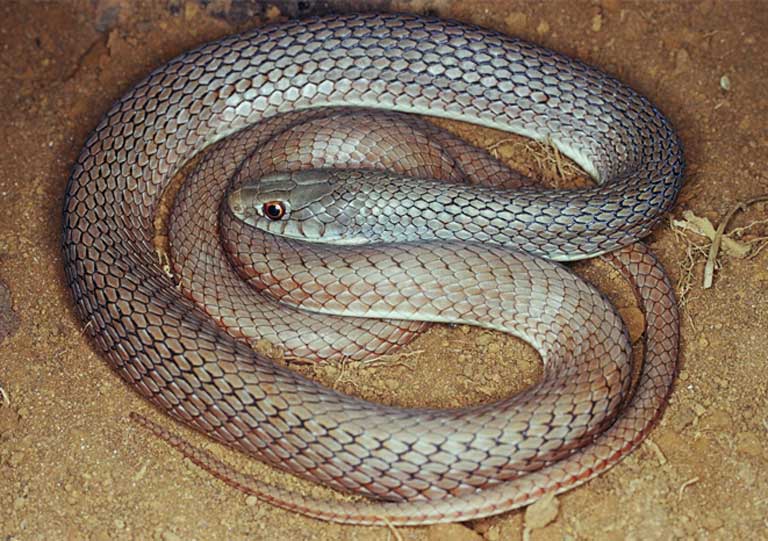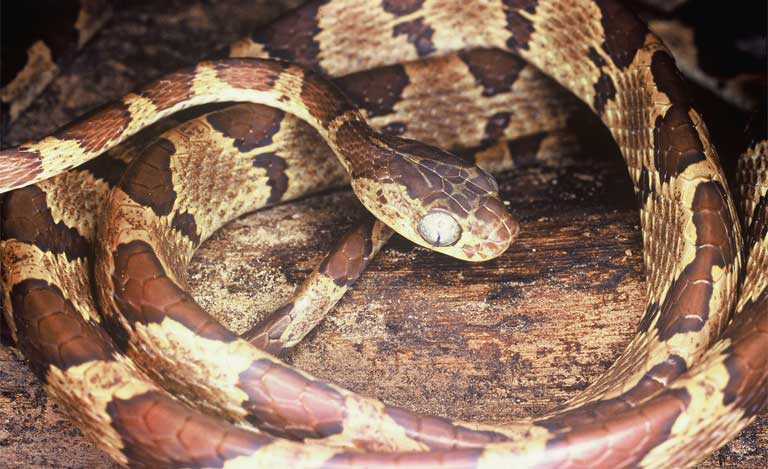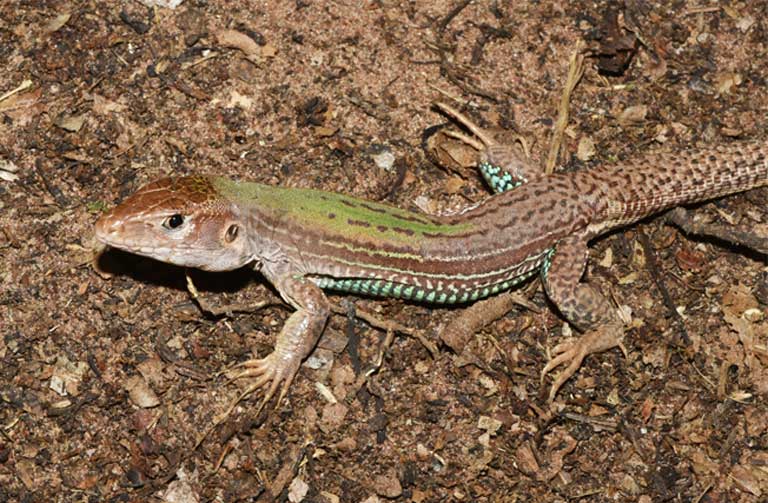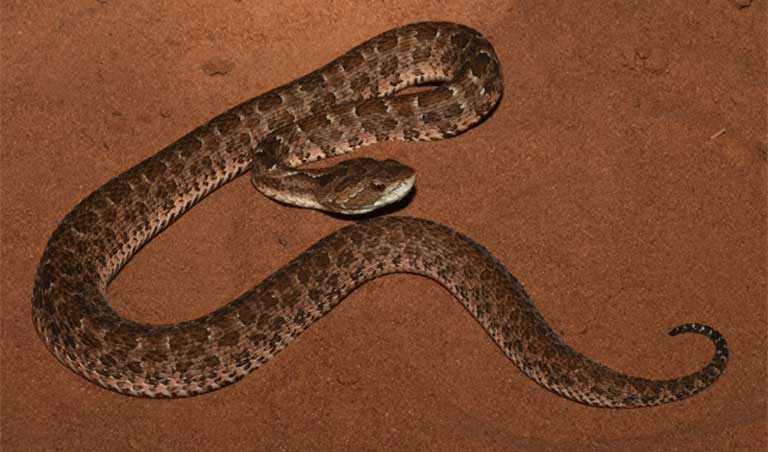- Brazil’s Cerrado is among the world’s most biodiverse savannas, covering two million square kilometers (772,204 square miles), nearly a quarter of the country and half the size of Europe.
- Once thought of as a “wasteland,” scientists have counted 208 snake species, some 80 lizards, 40 worm lizards, seven turtles and four crocodile species — many recently logged in the biome’s grasslands, palm-covered riverscapes, lowland forests and dry plateaus.
- But half of the Cerrado’s natural vegetation has been lost to mechanized agribusiness and ranching, with native plants and wildlife also at risk from climate change, and more frequent and intense fires. Today’s biome is fragmented, with just 3% under strict protection, and another 5% “protected” in farmed, inhabited mixed-use areas
- While researchers agree that there is an urgent need to protect large swathes of remaining savanna, there is also a vital requirement to preserve patches of unique habitat where diverse, niche-specialized reptilians make their homes.


When Cristiano Nogueira first spied the creature hiding in an underground burrow, he thought he had found a “lost species.” Stenocercus tricristatus, a diminutive, distinctively-spotted, prehistoric-looking lizard, hadn’t been seen for 175 years, and was known to science by just a single specimen kept in a drawer at the Paris Museum of Natural History. An infamous Danish expat collector, M. Claussen, had collected it somewhere in central Brazil back then, but no one knew exactly where.
Nogueira, a herpetologist and biogeographer, had traveled to Serra da Canastra National Park in Brazil’s southeastern Cerrado savanna just after a fire burned through: it’s the best time to find animals that are normally concealed by grasses in this rocky, highlands landscape.
Upon closer study back in the lab, he and his colleagues determined the animal’s true identity. “It wasn’t the lost species,” Nogueira said. “This beautiful spiny lizard, with two horns on top of its head, was a new species.”
That was in 2019. Remarkably, two decades into the 21st century, scientists are still discovering previously unknown species across central Brazil’s Cerrado biome.
In 2000, when Nogueira first proposed field research there as a graduate student, his professors told him he wouldn’t find much. “That was a vision based on poor data and poor sampling,” he said. “It was considered a wasteland.”


A biodiverse treasure trove
The Cerrado is among the world’s most diverse savannas, covering two million square kilometers (772,204 square miles), nearly a quarter of Brazil and half the size of Europe. But a mere 20 years ago, little was known about its wildlife beyond the most common or iconic species. Very few zoologists had ever even been there, and those who had, focused primarily on gallery forests, ignoring the savanna that makes up 61% of the biome.
Nogueira persisted in his quest. He convinced his professors and obtained Ministry of Environment maps that identified unstudied areas — and that’s where he went. Part herpetologist, part explorer, he spent four years traveling through a savanna matrix of grasslands, palm-covered riverscapes, low forests and dry plateaus in search of reptiles. He was among a handful of scientists that identified 57 new Cerrado reptile species from 1998 to 2008.
So far, about 208 snake species, some 80 lizards, 40 worm lizards, seven turtles and four crocodiles have been logged onto the region’s constantly expanding official species lists. The sheer numbers of Cerrado lizard and snake species catalogued rivals that of the much better protected Amazon, said Guarino Rinaldi Colli, a herpetologist at the University of Brasilia.



Researchers discovered that most of the snakes inhabited wide ranges; some areas harbored more than 50 species, scattered throughout a mosaic of landscapes. But many other Cerrado species occupied niches in particular habitats. Wet areas were predictably populated by the crocodiles.
The savanna’s grasslands were home to most of the lizards — likely because they’re heliotherms that regulate body temperature by basking in the sun. “They’re like little solar batteries,” Nogueira explained. Still other species live in burrows or leaf litter, representing sand dwellers, rock lizards, gallery forest denizens, and savanna species.
The strangest Cerrado reptiles may be the amphisbaenians, or worm lizards. They’re subterranean predators, up to three feet long with tiny limbs, small eyes and a spade-shaped skull. They undulate through tunnels, hunting in darkness.

Most of the newly discovered Cerrado endemics occupy narrow ranges; that’s likely because a lot of the wide-ranging species had already been found. Importantly, more than a third of the biome’s reptiles, about 38%, live nowhere else on earth.
That’s why the Brazilian Cerrado is considered a “biodiversity hotspot.” The biome is one of 36 areas around the world in need of emergency conservation according to the nonprofit Conservation International; that’s due to a dangerous combination of factors: many rare endemic species and their habitats are being rapidly decimated by human activities.
Trying to save these species, Nogueira said, is a race against time: “We are studying the Cerrado and its fauna, discovering new species at the same time they’re being erased from the map.”

A highly threatened landscape
The Cerrado was once a vast and lonely place — rejected by most Brazilians as uninhabitable. That began to change with the construction of Brazil’s new capital, Brasília, in the late 1950s, as frontier settlers began moving into the heartland. By the 1980s, agribusiness boomed in the southern Cerrado and the region was hailed as the new “breadbasket of the world.”
Over the past 40 years, about half of this vast, highly threatened landscape has been cleared for large-scale, mechanized agribusiness. The flat and rolling grasslands rapidly gave way to cash crops mostly for export, including soy, sugarcane, corn, cotton and eucalyptus. Huge areas of native vegetation were also converted to pasture. As of 2015, an estimated 135 million beef cattle grazed some 400,000 square kilometers (154,000 square miles) of savanna. It was far easier and cheaper to develop than the rainforest.
At first, very few cared about the loss of native vegetation. The grasslands lacked the towering trees and charismatic fauna that attracted conservationists to the Amazon.
The biome is now a disconnected landscape, diced into fragmented habitat patches, with most of the agricultural growth in the south, but with plantations and ranches steadily marching northward.



Reptiles at risk
With the loss of native habitat, many species suffer. But reptiles were particularly impacted by conversion to crop fields because they spend part of their lives underground, explained Marcio Martins, a zoologist at the University of Sao Paolo. “Many lizards and snakes live in burrows, small cavities or termite mounds, where they are protected from heat, fire and where they rest and lay eggs,” he said; that includes even big species, such as five- or six-foot snakes. They often “share” these cavities and tunnels with the armadillos, rodents or other animals that dig them. Snakes, for example, lay egg clutches beneath termite mounds.
But the big machines used by growers to rotate the soil eradicate these subterranean homes. “More than half of animals disappear when you grow soybeans or other crops,” Martins said, with specialist species especially hard hit. “Only a few generalists remain: rattlesnakes, maybe one species of lizard.” Diversity drops to almost zero on eucalyptus plantations, he added.
Cattle ranching also greatly diminishes biodiversity, as pastures planted with invasive grasses replace natural vegetation and animal waste pollutes waterways.

The Cerrado is now a prime operating zone for some of the world’s largest agricultural commodities companies, including transnationals like Cargill, Bunge, ADM, and Amaggi (who have resisted signing onto the Cerrado Manifesto decoupling soy production from deforestation); as well as major Brazilian beef processors JBS, Minerva, and Marfig (recently linked to major Cerrado native vegetation loss).
Overall, Cerrado species that live in wetlands or along rivers tend to be in better shape than those inhabiting grasslands where heavy agricultural equipment can operate. “You can’t put a tractor in a bog,” Nogueira said.
One savanna reptile may already have been driven to extinction. Nogueira was the last person to see Philodryas livida, an iconic brown racer native to the heavily-farmed south. He last glimpsed it 20 years ago.

Cerrado in flames
Reptiles here face yet another serious threat: fire.
While the dry Cerrado biome needs to burn — blazes are part of the natural cycle, burning away saplings and maintaining open savanna — humans have greatly altered the system.
Climate change and deforestation have made the region far hotter; rainfall is decreasing, and deepening drought is fueling more frequent, intense fires that engulf big chunks of habitat. With the landscape fragmented by farms, ranches, fences, roads, villages and cities, sometimes there’s nowhere for the animals to flee.
Agribusiness adds to the fire problem: most producers torch their land yearly to clear for planting. Ranchers incinerate tall grasses that cows won’t eat.
Some national park managers light controlled burns to prevent larger, more destructive blazes. Others suppress fire by clearing fire break zones, but that also comes with a cost. Trees encroach in unburned areas, and when a protected area inevitably ignites, there’s lots of accumulated fuel to feed a deadly inferno.
For half the year, the region can be as arid as a desert and vegetation regularly ignites. But Cerrado plants and animals have adapted to survive fire, having lived with its impacts for millennia. Massive underground root systems keep charred grasses alive. Some animals and birds are able to escape; others, including many reptiles, bunker in holes or burrows. One anole species, when reemerging from its refuge into a burned-over area, uses camouflage to hide from owls and other predators: its brown and mottled black coloring mimics a charred leaf.
But now, the natural order has been disturbed. Fires burn too frequently, too hot, or at the wrong time of year, placing these well-adapted plants and animals in peril. In its undisturbed state before European settlement, localized Cerrado patches burned maybe every few years, or once per decade. Now some areas burn every year, or during the wrong season. “It’s a matter of timing and scale,” said Nogueira. Scientists are rushing to understand the new fire regime and its effects on wildlife.


Reptilian prospects in a modern age of fire
For the past decade, biologists Martins and Colli have worked with a legion of researchers to understand the evolving impacts of fire on the Cerrado’s creatures. Some of these studies are part of a larger Brazilian Institute of Environment and Natural Resources (IBAMA) fire-fighting program that is expanding to consider more ecologically balanced fire management strategies, Martins said.
Since 2018, he’s worked in Jalapão, in eastern Tocantins state gathering data on the effects of fire on lizards and frogs and comparing diversity between burned and unburned areas. He’s surveyed residents before prescribed burns in protected areas, where rangers use flamethrowers to ignite a wall of fire. And he’s headed back in while the land is still smoldering to search for those that didn’t make it underground.
In one 12-day study, he located just seven lizard casualties across a huge area where he also counted 830 survivors from eight different species. “The percentage of lizards that die [in these fires] is very low,” Martins said. Mortality data isn’t available for snakes because they inhabit larger areas.
Years of research in the heavily-farmed southern Aguas de Santa Barbara area yielded similar findings. “The data shows almost no effect in richness or abundance of lizards or frogs,” he said.
However, these were prescribed burns in relatively natural protected savanna — not farmed or ranched areas, and these studies did not assess impacts from larger, deadlier blazes. Colli’s field research in the semi-forested central Cerrado plateau found that these lizard species did not fare as well. In general, landscape clearing fires favor sun-loving grassland species; under this new regime, forest-dwellers dwindle.
This research, ranging over multiple landscapes, revealed that some areas need to remain fire-free for longer periods, Colli said. “We’re trying to convince the managers of protected areas to implement fire management programs that mimic natural cycles.”


Conserving what remains
In 2008, Nogueira traveled to southeastern Brazil’s Planalto dos Gerais plateau to search for rock-dwelling lizards. He climbed an isolated hill, and there spied an undulating track beneath the sand that ended in a little clump of plants. There he found Bachia oxyrhina burrowed in the sandy soil — a new species, a tiny, limbless member of the “spectacled” lizard family, which are known for their transparent lower eyelids. B. oxyrhina offers a good example of why conservation is so challenging in the Cerrado’s fragmented habitats: It has never been found at another location.
Altitude and topography greatly determine what lives where in this highly-varied landscape — and the way the planet and life evolved here together explains why so many animals occupy narrow ranges. The tectonic shift that created the Andes Mountains six-to-10 million years ago also created more than a thousand flat-topped plateaus rising 3,000 to 5,000 feet — isolating a substantial number of endemic reptile species.
So, while fully protecting the remaining swathes of Cerrado native vegetation is important to conserving fauna and flora, conserving a mosaic of smaller areas of habitat vital to these “gap species” is just as important, Nogueira said.
Planning for future protected areas must consider evolving climate change scenarios, Colli said. He suggests that “edge species” living at the periphery of ecosystems may have the best odds of surviving climate change because they’re pre-adapted for resilience under changing conditions.
Unfortunately, there’s little government action to conserve the Brazilian Cerrado. Currently, just 3% of the biome is under strict protection; another 5% is “protected” as mixed-use areas where people live, grow crops, ranch, and are legally required to conserve land — though there’s little compliance or enforcement. By comparison, 17% of the planet’s terrestrial land was supposed to be conserved by 2020 under the Convention on Biological Diversity (CBD) international treaty.



Large plantations and ranches continue to consume remaining Cerrado habitat, with many agribusiness operations allegedly established on lands acquired via bribery and by other potentially illegal means, even while being funded by international investment firms. Harvard University’s gigantic investment fund, for example, has contributed $450 million, most of it to buy up at least 405,000 hectares (1 million acres) of Cerrado, some of it occupied by alleged land grabbers in conflict with traditional communities.
Experts say that making better use of already cleared degraded agricultural land and restoring its native vegetation — while giving special attention to at-risk species such as the giant armadillo or the maned wolf could slow the destruction. Meanwhile, authors of a 2016 study published in Nature called for urgent action on “a severe extinction episode unfolding in the Cerrado.”
However, the baseline information needed to conserve many reptile species is lacking: behavior, reproduction, population size, and conservation status are little-known for many species said Colli. “And then there are likely undiscovered species,” he added.
Snakes are vital to ecosystems, keeping rodents from overpopulating. Lizards play an important role, too, by controlling insects, including pests that impact crops. They are also a staple food for birds and other animals.
Saving reptiles could save much more. “They can act as ‘surrogate species,’” Colli said, because many birds and mammals cope with environmental change better than the snakes, frogs and lizards they share the land with. “So if we protect them, we will protect a lot of other species,” he said.
The clock is ticking and time is running out. “There is still an opportunity to do something,” said Nogueira, “but that opportunity is vanishing quickly. It’s cheaper to protect than restore, but we need to act before there’s nothing left to protect.”
Banner image: An undescribed Apostolepis (a burrowing snake) found in the recently created Chapada das Mesas National Park in Maranhão state. Many newly found species are already in collections around Brazil, but still await formal description. Many more are yet to be sampled in the field. Image by Cristiano Nogueira.
FEEDBACK: Use this form to send a message to the author of this post. If you want to post a public comment, you can do that at the bottom of the page.

